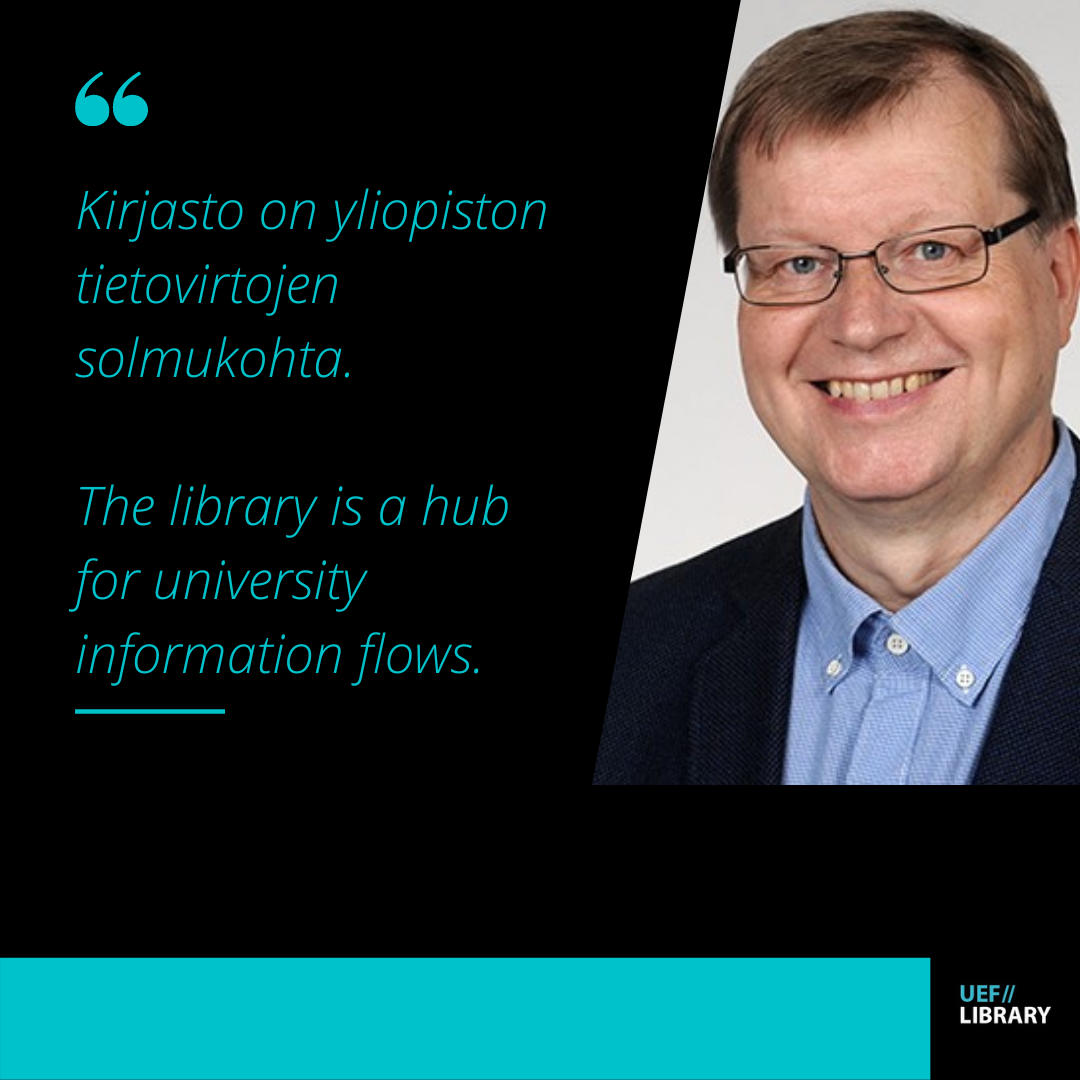Miksi kirjasto tulee olemaan? | Why will the library exist?
(Please, scroll down to read in English.)
Edeltäjäni kirjastonjohtaja Jarmo Saarti kirjoitti tässä blogissa 3.8.2021 otsikolla Miksi kirjasto on? Hän kertoi intialaisen kirjastonhoitaja S. R. Ranganathanin laeista ja siitä, miten ne pätevät tänäkin päivänä. Minä jatkan Jarmon ajatuksista ja kerron, miksi kirjasto tulee olemaan myös tulevaisuudessa.
Kirjasto ei ole yliopistossa itsestäänselvyys. Esimerkiksi Aalto-yliopisto on hajauttanut kirjaston toiminnot neljään eri yksikköön ja Jyväskylän yliopistossa kirjasto ja yliopiston kaksi museota yhdistettiin Avoimen tiedon keskukseksi. Jokaisen yksikön pitää pystyä perustelemaan olemassaolonsa joka päivä. Sillä on oltava ydin, joka ei ole siirrettävissä muualle.
Kirjaston ydin on tiedon järjestäminen sekä asiakkaiden tuntemus. Kirjastolaisten on tunnettava asiakkaansa, heidän tiedontarpeensa sekä yliopiston tutkimuksen ja opetuksen tieteenalat. Kirjaston on parhaimmillaan osattava ennakoida, mitä tullaan tutkimaan ja opettamaan, jotta tarvittavat julkaisut ovat käytettävissä heti, kun niitä tarvitaan. Tämä toteuttaa näkemykseni mukaan Ranganathanin toista lakia “joka lukijalle kirja”.
Ranganathanin viides laki kuvaa kirjastoa kasvavana organismina. Parin viimeisen vuosikymmenen aikana kasvu on siirtynyt sähköiseen maailmaan. Kun vielä 90-luvun alussa kirjasto tilasi parhaimmillaan muutamia tuhansia tieteellisiä lehtiä, nykyisin niitä on asiakkaiden käytettävissä kymmeniä tuhansia. Vastaava murros on tapahtunut kirjojen kohdalla. Vielä toistaiseksi lisenssiehdot rajaavat käytön yliopiston osoiteavaruuteen, mutta toiveissani on, että lähitulevaisuudessa kaikki tämä aineisto on avoimesti saatavilla.
Tällaisen valtavan tietomassan käyttö edellyttää hyvää tiedon järjestämistä. Googlaamalla löytää aina jotain, mutta kirjasto voi asiantuntemuksellaan luoda lisäarvoa asiakkailleen. Olennaista tiedon järjestämisessä on metatiedon hallinta, ja se on kirjaston kovaa ydintä. Aineistojen kuvailu tietokantoihin auttaa asiakkaita suodattamaan itselleen tärkeää tietoa. Yliopiston omat julkaisut, tutkimusdata ja kohta myös oppimateriaalit on kuvailtava, jotta ne löytävät käyttäjänsä maailmalla.
Lukijan ajan säästämiseksi (Ranganathanin neljäs laki) kirjasto ei vain järjestä tietoa, vaan tukee myös sen hankinnassa ja hallinnassa. Avoimen tieteen tuntemus on tärkeä osa tutkimustaitoja, siinäkin kirjasto voi auttaa asiakkaitaan osaamisellaan.
Kirjasto on yliopiston tietovirtojen solmukohta. Se hankkii ja välittää aineistoja asiakkailleen, mutta myös tarjoaa yliopiston tuottamaa avointa tietoa koko maailman käyttöön.
Siksi kirjasto on edelleen tärkeä osa yliopistoa.

My predecessor, library director Jarmo Saarti, wrote on this blog on August 3, 2021, entitled Why does the library exist?“. He spoke about the laws of Indian librarian S. R. Ranganathan and how they apply to this day. I will continue with Jarmo’s thoughts and explain why the library will be in the future as well.
It is not self-evident that a university has a library. For example, Aalto University has decentralized the library’s functions into four different units, and at the University of Jyväskylä, the library and the university’s two museums were merged into the Open Science Center. Every unit needs to be able to justify its existence every day. It must have a core that is not transferable elsewhere.
The core of the library is its ability to organize information as well as knowledge of the needs of its customers. Librarians need to know their clients, their information needs, and the disciplines of university research and teaching. At its best, the library is able to anticipate what will be researched and taught in order to acquire necessary publications just on time. This, in my view, implements Ranganathan’s second law, “every reader a book”.
Ranganathan’s fifth law describes the library as a growing organism. Over the last two decades, growth has shifted to the electronic world. While in the early 1990s, the library at its best subscribed to a few thousand scientific journals, today there are tens of thousands of them available to customers. A similar revolution has taken place for books. For the time being, the licence terms limit use to the university’s address space, but I hope that all of this material will be openly available in the near future.
The use of such a huge amount of data requires good information organization. Google always finds something, but with its expertise, a library can add value to its customers. Metadata management is essential in organizing information, and it is the hard core of a library. Describing materials to databases helps customers filter information that is important to them. The university’s own publications, research data and soon also the study materials must be described in order for them to find their users in the world.
To save reader’s time (Ranganathan’s fourth law), the library not only organizes information but also supports its acquisition and management. Knowledge of open science is an important part of research skills, and even here the library can help its customers with its expertise.
The library is a hub for university information flows. It acquires and distributes materials to its clients, but also provides open information produced by the university for use worldwide.
Therefore, the library is still an important part of the university.
Ari Muhonen, kirjaston johtaja | Library Director